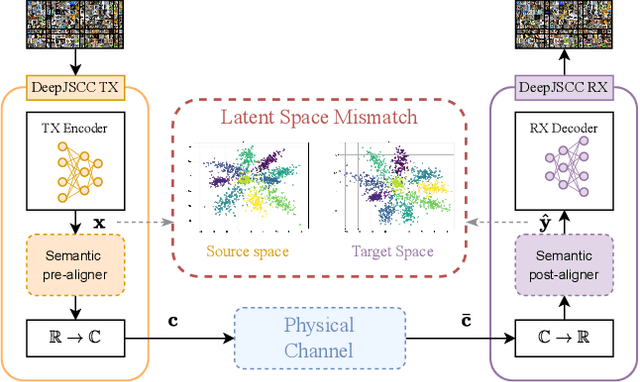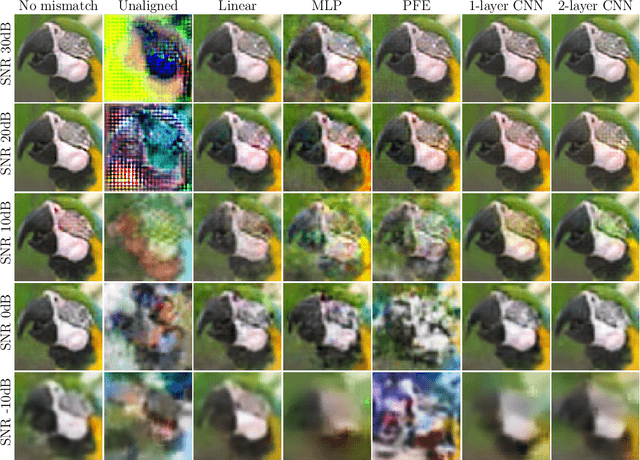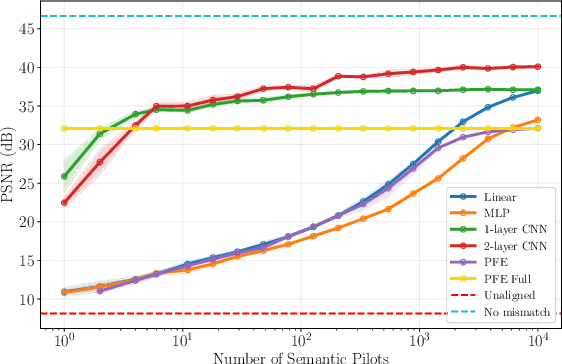Mario Edoardo Pandolfo
Semantic Channel Equalization Strategies for Deep Joint Source-Channel Coding
Oct 06, 2025



Abstract:Deep joint source-channel coding (DeepJSCC) has emerged as a powerful paradigm for end-to-end semantic communications, jointly learning to compress and protect task-relevant features over noisy channels. However, existing DeepJSCC schemes assume a shared latent space at transmitter (TX) and receiver (RX) - an assumption that fails in multi-vendor deployments where encoders and decoders cannot be co-trained. This mismatch introduces "semantic noise", degrading reconstruction quality and downstream task performance. In this paper, we systematize and evaluate methods for semantic channel equalization for DeepJSCC, introducing an additional processing stage that aligns heterogeneous latent spaces under both physical and semantic impairments. We investigate three classes of aligners: (i) linear maps, which admit closed-form solutions; (ii) lightweight neural networks, offering greater expressiveness; and (iii) a Parseval-frame equalizer, which operates in zero-shot mode without the need for training. Through extensive experiments on image reconstruction over AWGN and fading channels, we quantify trade-offs among complexity, data efficiency, and fidelity, providing guidelines for deploying DeepJSCC in heterogeneous AI-native wireless networks.
Latent Space Alignment for AI-Native MIMO Semantic Communications
Jul 24, 2025Abstract:Semantic communications focus on prioritizing the understanding of the meaning behind transmitted data and ensuring the successful completion of tasks that motivate the exchange of information. However, when devices rely on different languages, logic, or internal representations, semantic mismatches may occur, potentially hindering mutual understanding. This paper introduces a novel approach to addressing latent space misalignment in semantic communications, exploiting multiple-input multiple-output (MIMO) communications. Specifically, our method learns a MIMO precoder/decoder pair that jointly performs latent space compression and semantic channel equalization, mitigating both semantic mismatches and physical channel impairments. We explore two solutions: (i) a linear model, optimized by solving a biconvex optimization problem via the alternating direction method of multipliers (ADMM); (ii) a neural network-based model, which learns semantic MIMO precoder/decoder under transmission power budget and complexity constraints. Numerical results demonstrate the effectiveness of the proposed approach in a goal-oriented semantic communication scenario, illustrating the main trade-offs between accuracy, communication burden, and complexity of the solutions.
RIS-aided Latent Space Alignment for Semantic Channel Equalization
Jul 23, 2025Abstract:Semantic communication systems introduce a new paradigm in wireless communications, focusing on transmitting the intended meaning rather than ensuring strict bit-level accuracy. These systems often rely on Deep Neural Networks (DNNs) to learn and encode meaning directly from data, enabling more efficient communication. However, in multi-user settings where interacting agents are trained independently-without shared context or joint optimization-divergent latent representations across AI-native devices can lead to semantic mismatches, impeding mutual understanding even in the absence of traditional transmission errors. In this work, we address semantic mismatch in Multiple-Input Multiple-Output (MIMO) channels by proposing a joint physical and semantic channel equalization framework that leverages the presence of Reconfigurable Intelligent Surfaces (RIS). The semantic equalization is implemented as a sequence of transformations: (i) a pre-equalization stage at the transmitter; (ii) propagation through the RIS-aided channel; and (iii) a post-equalization stage at the receiver. We formulate the problem as a constrained Minimum Mean Squared Error (MMSE) optimization and propose two solutions: (i) a linear semantic equalization chain, and (ii) a non-linear DNN-based semantic equalizer. Both methods are designed to operate under semantic compression in the latent space and adhere to transmit power constraints. Through extensive evaluations, we show that the proposed joint equalization strategies consistently outperform conventional, disjoint approaches to physical and semantic channel equalization across a broad range of scenarios and wireless channel conditions.
 Add to Chrome
Add to Chrome Add to Firefox
Add to Firefox Add to Edge
Add to Edge